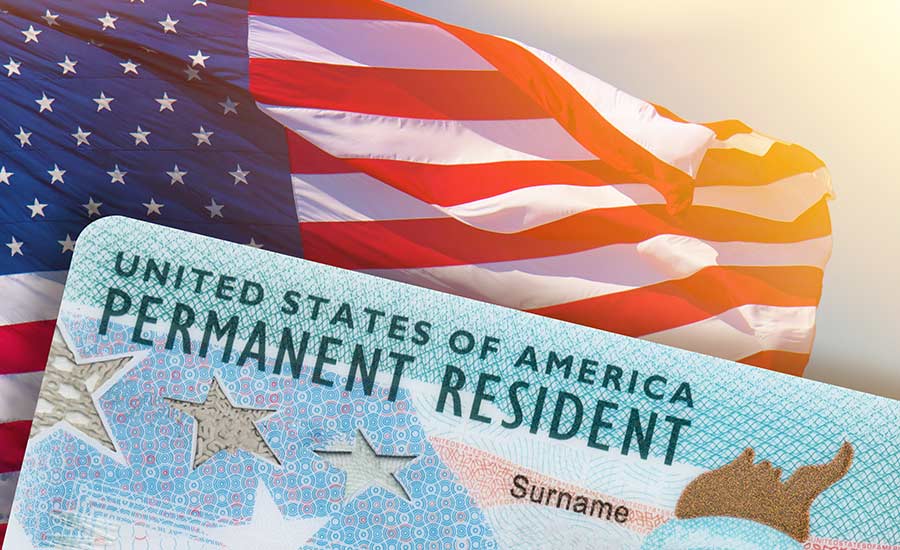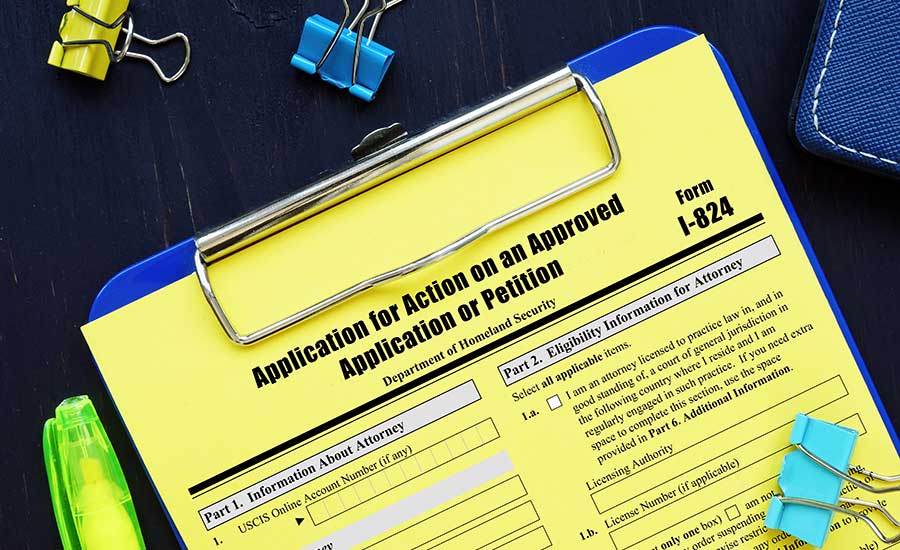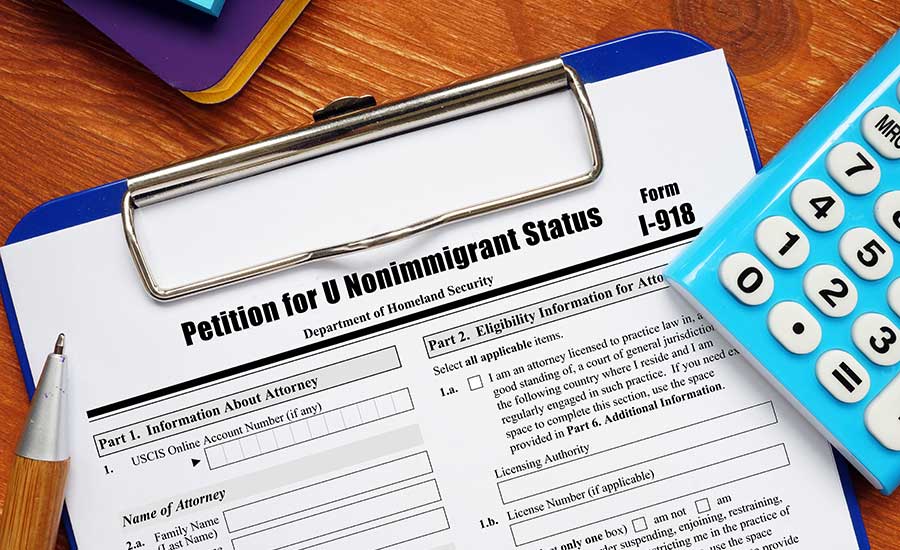

What is a Green Card and how can you obtain one?
If you want to learn more about Green Card types and application steps, this article is for you.
We’ll address common questions and share how Spar & Bernstein can help you get a Green Card and become a lawful permanent U.S. resident.
What Is A Green Card?
A Green Card, also known as Form I-551 or Permanent Resident Card, is a document issued by the U.S. government that allows non-U.S. citizens to:
- Live and work permanently in the United States
- Travel and return if their trip doesn’t exceed six months (unless they are in possession of a re-entry permit, Form I-131)
- Apply for U.S. citizenship (if eligibility requirements are met)
Read more about Green Card benefits in our recent article.
Green Cards are typically valid for 10 years. They can be renewed or replaced when lost, stolen, or damaged using Form I-90, Application to Replace Permanent Resident Card (Green Card).
The History Of The Green Card
The history of the Green Card started with the Alien Registration Act of 1940, which required all noncitizens in the U.S. to register with the government. Initially, all noncitizens received the same registration card on white paper (Form AR-3), regardless of their immigration status.
After World War II, the process evolved. Lawful permanent residents (LPRs) were given Form I-151, printed on green paper (hence Green Card), while other noncitizens received different documents. The “Green Card” became vital proof of LPR status — particularly for employment, as employers required it.
Over the years, the color of the permanent resident card was changed several times, transitioning to blue, pink, or tan.
In 2010, the U.S. Citizenship and Immigration Services (USCIS) reintroduced green into the design, adding red, white, and blue.
The card is still called a “Green Card,” referencing its original green color, which became a symbol of immigrants’ right to live and work in the U.S.
Learn how a Green Card differs from a visa.
Types Of Green Cards
Green Cards differ based on the relationship between the sponsor petitioning for the immigrant and the beneficiary seeking permanent residency.
Below you will find some of the types of Green Cards.
Family-Based Green Cards
You can apply for a family-based Green Card if you are a relative of a U.S. citizen or Green Card holder who acts as your sponsor.
- If you are an immediate relative of a U.S. citizen, such as a spouse, unmarried child under 21, or parent, there is no annual cap, and a Green Card is always available.
- If you are applying under family preference categories — for example, as a sibling or married child of a U.S citizen, spouse and child under 21 of a Green Card holder, and more, there is annual quota, and you might face significant wait times depending on your country of origin.
Employment-Based Green Cards
You can apply for an employment-based Green Card, if you have a job offer from a U.S. employer or based on your professional skills and achievements.
Employment-based Green Cards are divided into several categories, each with different eligibility requirements and quota:
- EB-1: For individuals with extraordinary abilities in arts, sciences, education, business, or athletics, researchers, and multinational executives or managers. The annual quota for EB-1 is 40,000 visas.
- EB-2: For professionals with advanced degrees or exceptional abilities in specific fields. To file for a Green Card, applicants need a job offer and labor certification (an exception is if they qualify for a National Interest Waiver). The annual quota for EB-2 is 40,000 visas.
- EB-3: For skilled workers, professionals with a minimum bachelor’s degree, and certain unskilled workers. The annual cap for EB-3 is 40,000 visas.
- EB-4: For special immigrants — religious workers, broadcasters, employees of international organizations, and U.S. armed forces members. The annual quota for EB-4 is 9,940 visas.
- EB-5: For investors who invest in targeted employment areas in new commercial enterprises, creating full-time jobs for U.S. workers. The annual quota for EB-5 is 9,940 visas.
Humanitarian Green Cards
You can apply for a humanitarian Green Card if you have suffered persecution, violence, or other challenging circumstances.
- Asylees and refugees: They can apply for a Green Card one year after being granted humanitarian status.
- Victims of human trafficking or crime: T visa and U visa holders can apply for a Green Card after maintaining their status for three years and meeting other eligibility requirements.
- Abused spouses, children, or parents: They can self-petition for a Green Card without a sponsor under the Violence Against Women Act.
Diversity Lottery Green Cards
Another route to getting a Green Card is through the Diversity Immigrant Visa Program, which attracts individuals from countries with low immigration rates to the United States.
To participate in the program, you must:
- Be from a qualifying country
- Meet education or job experience requirements
While winning the lottery doesn’t guarantee a Green Card, it gives chosen applicants the chance to apply for it.

How To Apply For A Green Card
While the Green Card application process can differ per category, it typically includes the following steps:
1. Determine Eligibility
Identify the category under which you can file for a Green Card, whether family-based, employment-based, humanitarian, or other.
Check the eligibility requirements and whether your category requires sponsorship by a U.S. citizen, lawful permanent resident, or employer.
2. File The Right Petition
- If you are applying for a family-based Green Card, file Form I-130, Petition for Alien Relative.
- If you are applying for an employment-based Green Card, the sponsoring employer must file Form I-140, Immigrant Petition for Alien Worker.
- If you are self-petitioning based on employment (EB-1 category or applying for a National Interest Waiver under the EB-2 category), file Form I-140 on your own behalf.
- If you are applying for a Green Card under VAWA, file Form I-360, Petition for Amerasian, Widow(er), or Special Immigrant.
3. File For Adjustment Of Status Or Go Through Consular Processing
- If you are in the U.S. and meet the eligibility requirements, file Form I-485, Application to Register Permanent Residence or Adjust Status.
- If you are outside the U.S., apply for an immigrant visa through the U.S. Department of State at a U.S. Embassy or Consulate in your home country. To do this, file Form DS-260, Immigrant Visa Electronic Application.
4. Go For Biometrics
Attend a biometrics appointment at a USCIS office or at a U.S. Embassy or Consulate, where your fingerprints, photograph, and signature will be taken for background checks.
5. Attend An Interview
Attend an interview with a USCIS officer or a consular officer, during which they will verify your eligibility, review your application, and ask questions about your petition.
6. Wait For A Decision
- If your application is approved and you are applying from within the U.S., your Green Card will be mailed to you.
- If your application is approved and you are applying from outside the U.S., you will receive an immigrant visa, allowing you to enter the U.S. as a permanent resident. You’ll receive your physical card after your arrival in the U.S.
- If additional information is needed, you will receive a Request for Evidence (RFE) to provide more documents.
- If your application is denied, you will be informed of the reasons and might have the right to appeal the decision.

Need Help With Your Green Card Application? Contact Spar & Bernstein
With 60+ years of experience, The Law Offices of Spar & Bernstein have helped thousands of individuals and families turn their dream of living in the U.S. into a reality.
Approaching each case with care and compassion, our knowledgeable lawyers will:
- Assess your eligibility for a Green Card
- Help you prepare and file the immigration forms for your situation
- File waivers if you face challenges with inadmissibility or financial problems
- Appeal decisions if your Green Card application is denied
- Help you comply with immigration laws if you are an employer sponsoring an employee
Our experienced team of immigration attorneys eliminates potential pitfalls and supports you every step of the way.
How To Get A Green Card: FAQs
Applying for a Green Card can raise many questions. If you have not found what you were looking for in the sections above, read on.
Is there an annual quota for Green Cards?
Yes, there are limits for certain categories — for example, employment-based Green Cards and some family-based preference categories.
Can I work in the U.S. while my Green Card application is pending?
Yes, you can work in the U.S. while your Green Card application is pending. Use Form I-765 to apply for a work permit (Employment Authorization Document).
Can my employer withdraw their sponsorship for my Green Card?
Yes, your employer can withdraw their sponsorship at any time before you get a Green Card. If this happens, you will need to find a new employer to sponsor you or check if you can self-petition for a Green Card.
Does a Green Card give me access to public benefits?
You may have the right to use federal and state benefits, such as health insurance and housing assistance. However, you may need to meet certain criteria to access them.
Can my Green Card be revoked?
Yes, your Green Card can be revoked if you commit a serious crime, give false information when applying, or fail to maintain U.S. residency.





